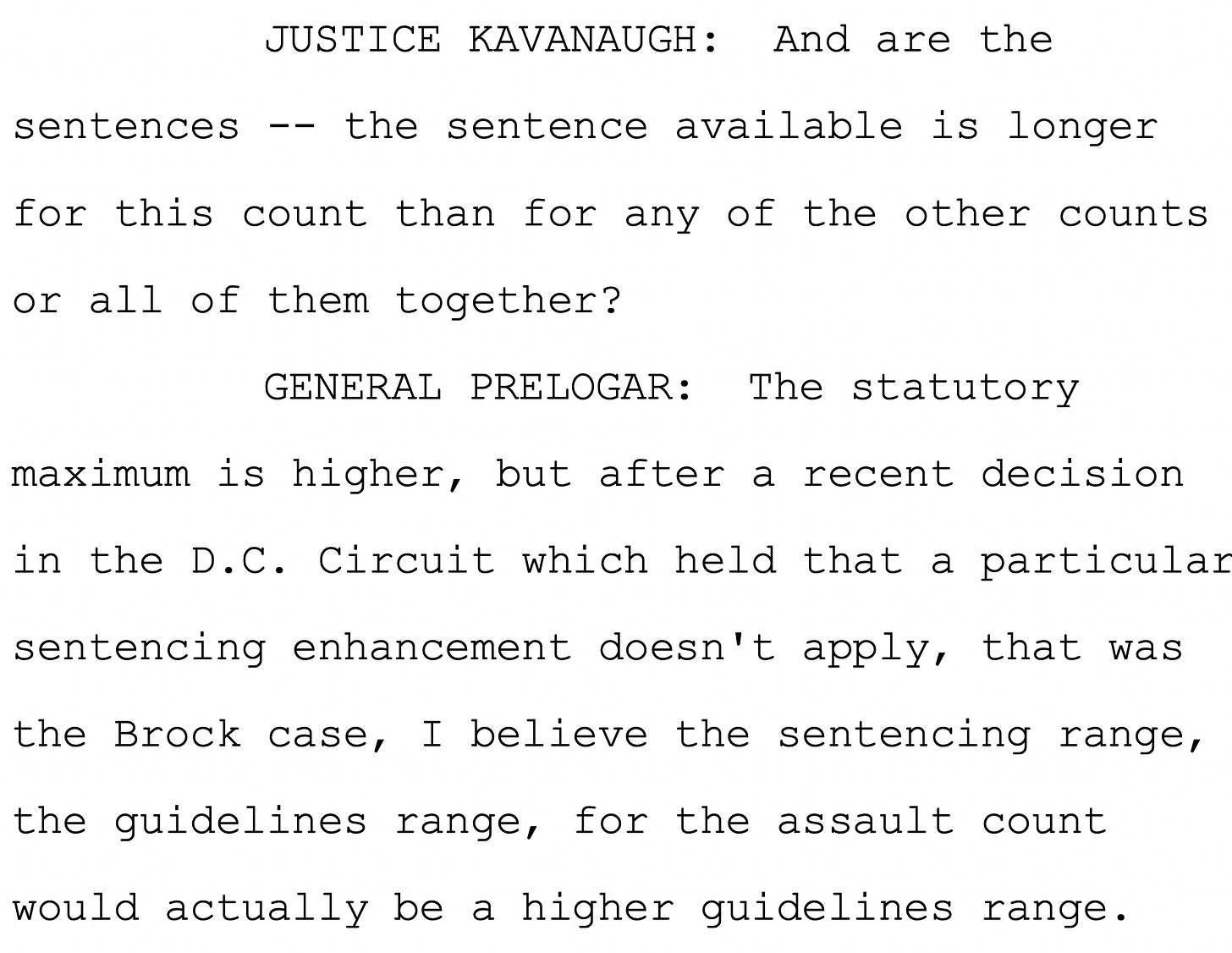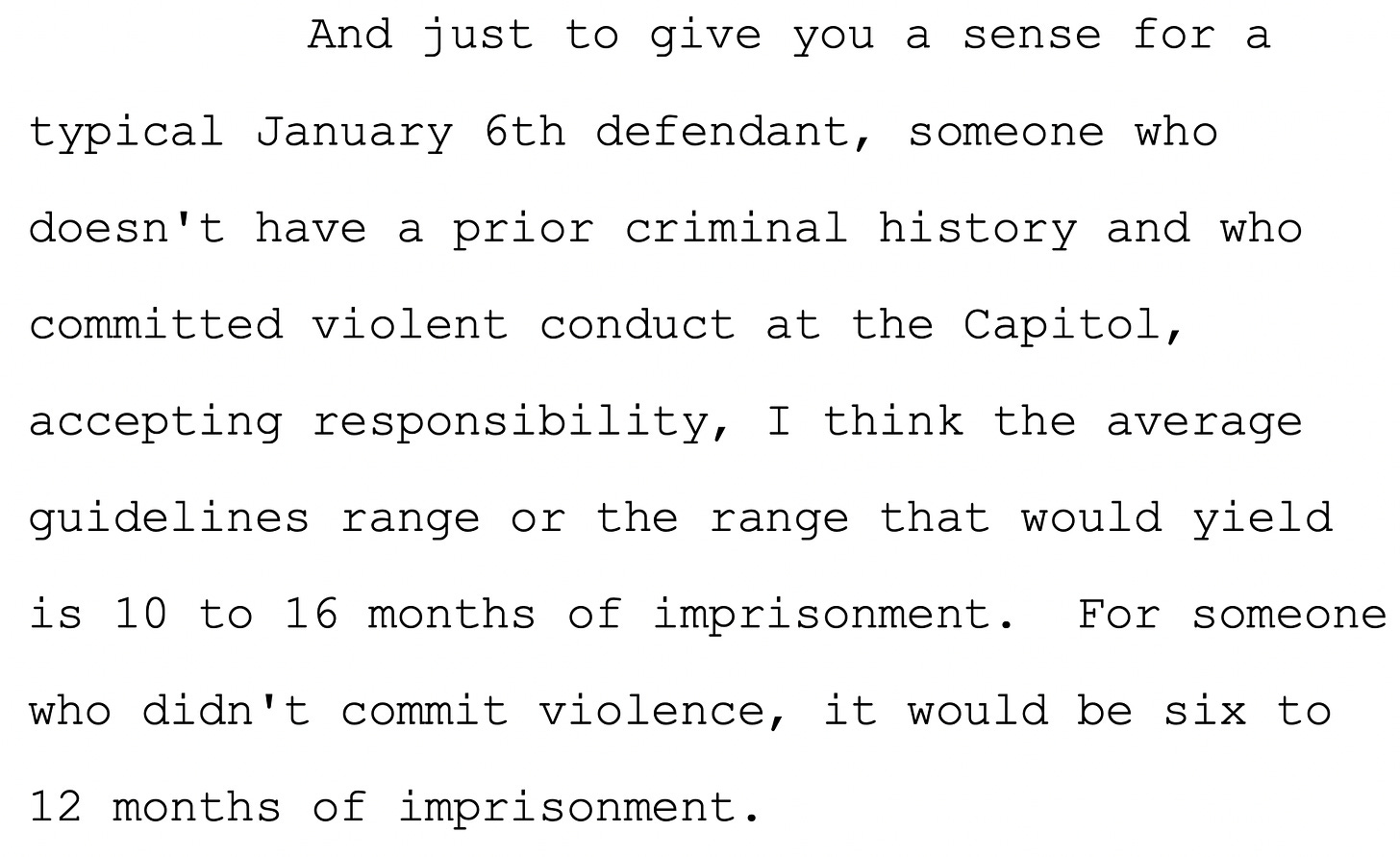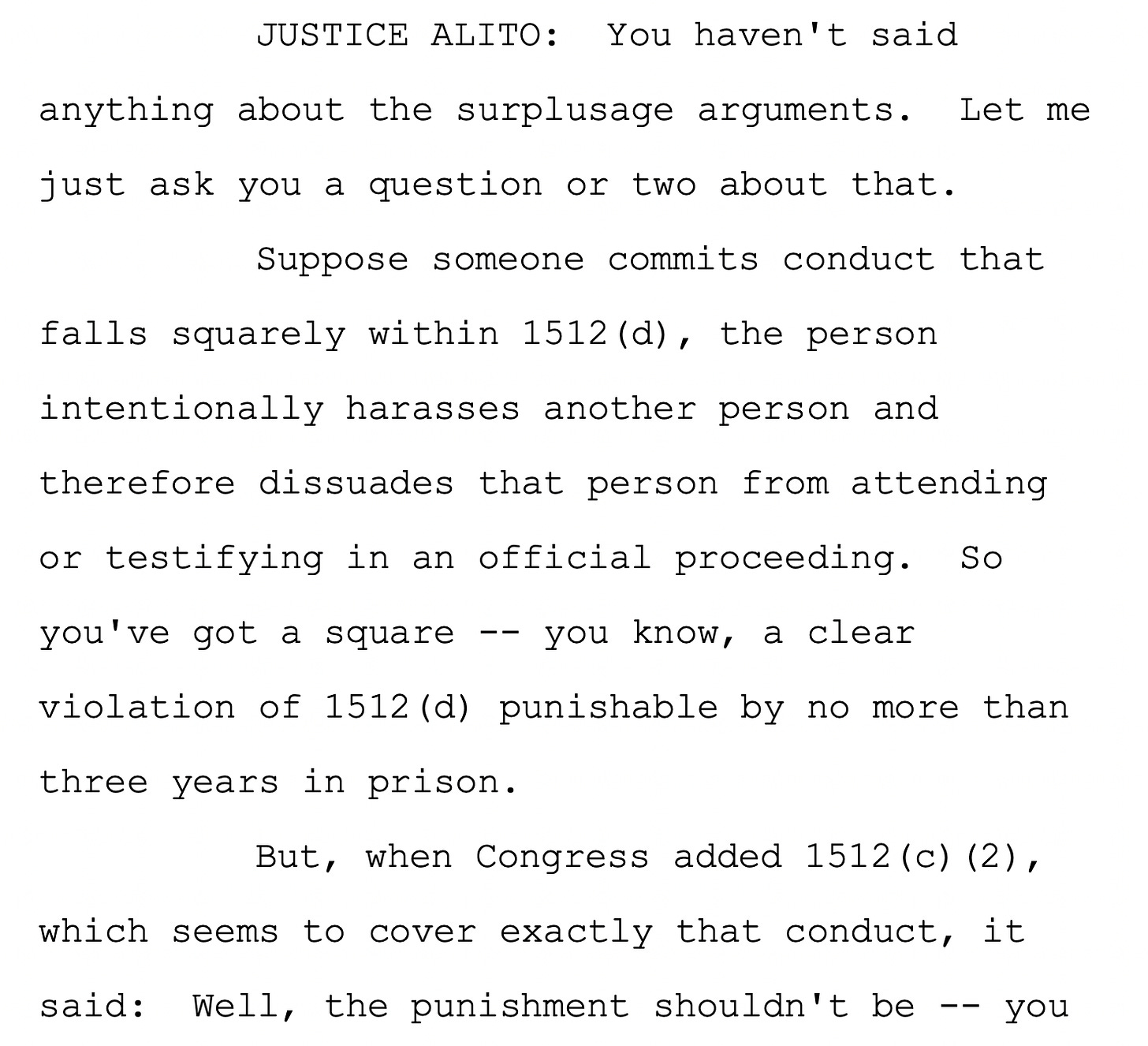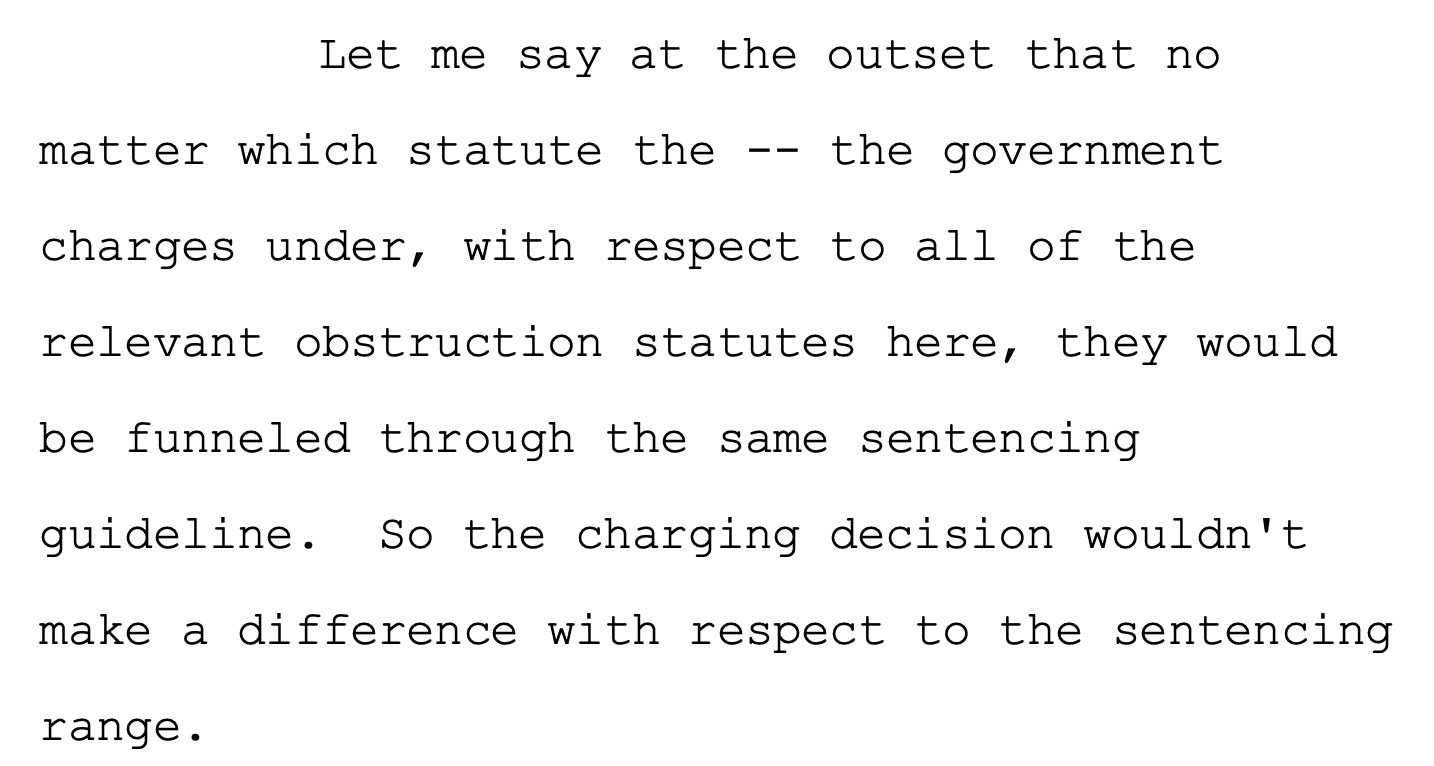![]()

by Shipwreckedcrew
I listened very closely — twice — to the audio of the oral argument before the Supreme Court on April 16 in the case of Fischer v. United States, concerning whether the Department of Justice’s use of a particular criminal “obstruction of justice” statute to prosecute defendants charged in connection with the Capitol protest on January 6, 2021. The question before the Court is whether DOJ’s use of the particular statute — 18 U.S.C. Sec. 1512(c)(2) — is consistent with the purposes for which Congress passed that statute to criminalize wide-scale document destruction of business records by the accounting firm Arthur Andersen ahead of the DOJ investigation into ENRON.
This article isn’t about the overall nature of the oral argument or what it might portend for the outcome of the case — that’s a deeper dive that is going to require more time than I have right now.
This article is about the exchange over sentences imposed on January 6 defendants who have been convicted on of violating Sec. 1512(c)(2), and the duplicity of the Solicitor General on the subject when she tried to “pour cold water” on concerns expressed by multiple Justices over the use of “20 year felony” to address actions by defendants on that day.
The following are excerpts the transcript on the subject so you can understand precisely the exchange that had me wanting to throw my coffee cup across the room:




This exchange developed from earlier comments by other Justices questioning whether Congress meant for a statute with a 20 year maximum sentence to be applied in circumstances where the logical extension of DOJ’s application of the statute to January 6 defendants could also bring in much more minor and benign forms of “obstructive” conduct. Examples given were a handful of protesters interrupting a Supreme Court session or someone — Rep. Jamal Bowman — pulling a fire alarm to stop a congressional vote.
This exchange developed from earlier comments by other Justices questioning whether Congress meant for a statute with a 20 year maximum sentence to be applied in circumstances where the logical extension of DOJ’s application of the statute to January 6 defendants could also bring in much more minor and benign forms of “obstructive” conduct. Examples given were a handful of protesters interrupting a Supreme Court session or someone — Rep. Jamal Bowman — pulling a fire alarm to stop a congressional vote.
In an effort to deflect attention away from the maximum sentence provided for in the statute, the Solicitor General pointed the Court in the direction of looking at the application of the sentencing guidelines, which led her to later quote the numbers to Justice Kavanaugh above.
Here is one of the earlier exchanges that caused her radar to go off:



This is just wrong in so many ways that it raises a question for me as to whether Solicitor General Prolegar has ever been a DOJ prosecutor. Different obstruction statutes have different statutory maximums — some as low as 3 years. That means that a judge cannot impose a sentence of more than 36 months for a violation of that particular statute with that statutory maximum.
As noted in more detail below, the government has sought sentences under the Sentencing Guidelines far in excess of 36 months for Sec. 1512(c)(2) convictions. The reason they have been able to do that is because the maximum sentence allowed for a Sec. 1512(c)(2) violation is 20 years — 240 months. So while the Guidelines might be the same, using Sec. 1512(c)(2) gives DOJ massive amounts of “running room” to ask for whatever length of sentence they crave for a particular January 6 defendant.
The Solicitor General saw the obvious need to downplay the significance of the fact that Sec. 1512(c)(2) has a 20 year maximum, while many other subsections of Sec. 1512, and other obstruction statutes as well, have much lower statutory maximums — some as low as 3 years.
In attempting to take the focus off the 20 year statutory maximum — by representing that relatively “short” sentences she claimed have been imposed for Sec. 1512(c)(2) offenses make the statutory maximum something that should not concern the Court — what the Solicitor General did not confess is that DOJ prosecutors have advocated in writing and at sentencing hearings for sentences far longer than the 24-26 month sentencing figures she gave the Court.
The 50 specific cases she referred to in order to come up with those numbers — cases where Sec. 1512(c)(2) was the only felony conviction according to her — almost exclusively involve defendants coerced into pleading guilty to that offense pursuant to a plea agreement where the government dictated the terms with a “take it or leave it” offer. Because they were guilty pleas, the defendant benefitted from having done to the tune of about 18 months compared to defendants who go to trial and are convicted. So her “cherry-picked” data set of 50 out of 350 — the number who have been convicted on Sec. 1512(c)(2) — produces the lowest possible numbers in terms of mean and median sentences imposed that she could have come up with.
When the prosecution is winning 99.75% of jury trials, and their offer to you is “accept these terms or go to trial”, a defendant really doesn’t have much in the way of leverage to “bargain” for changes in the terms of the offer.
The plea agreements from DOJ offering a guilty plea to a single felony of violating Sec. 1512(c)(2) required the defendant to STIPULATE to certain sentencing enhancements — more on that below — and that the range of imprisonment under the Sentencing Guidelines based on those stipulated-to enhancements was typically 41-51 months for a first-time offender with no criminal history. The agreements provided that a defendant could argue to the judge at sentencing for a lower sentence — below the guideline range — but the defendant had to agree that the range set forth by the Government was correct. Under federal sentencing procedures, that range is where the sentencing judge begins his/her analysis. The judge could go lower — or higher — depending on a variety of factors, but the purpose of the guidelines is to bring some consistency to sentencing across the country. Most judges will typically impose a “guideline sentence” — meaning within the range — absent some significant mitigating factor favorable to a defendant that justifies “varying downward.” After all, the two sides agreed in the plea agreement that was the applicable range.
One group of defendants omitted by the cherry-picking of data by DOJ are defendants who went to trial and were convicted. If it was important to the Justices to know that sentences imposed were far below the 240 month maximum possible sentence when Sec. 1512(c)(2) was the only felony, it was just as relevant for them to know the range of sentences in other cases. Instead, DOJ culled the lowest possible outcomes it could isolate from complete list of defendants sentenced for the Sec. 1512(c)(2) offense. The sentences sought and imposed on defendants not in the cherry-picked data set are just as relevant to the inquiry made by Justice Kavanaugh as were the cherry-picked numbers she spouted.
Also omitted from the selected set of 50 defendants are any defendants who had more than one felony conviction. I’m quite certain — because I’ve seen dozens of examples over 30+ months of defending these cases — that many defendants have been given plea offers that required them to plead guilty to two felonies, not just one. The second felony is usually a violation of Sec. 111(a), Assaulting, Impeding, Interfering, etc. — with a Federal Law Enforcement Officer; or a violation of Sec. 231 — “Civil Disorder.” Defendants who have taken such plea offers would be excluded from the cherry-picked data set which was limited to defendants who were guilty of only one felony, the Sec. 1512(c(2) charge.
Why is this third group’s exclusion important? Because when you have more than one felony there are “grouping” provisions that increase the offense level under the guidelines, and that results in a higher guideline range and a longer sentence. I will not explain because you’ll want to stab yourself in the eyes with a fork.
The Solicitor General excluded defendants with more than one felony conviction from her data set.
These two excluded groups — comprising close to 300 defendants — have sentences or potential sentences much higher than the 24-26 month average given to the Court by the Solicitor General. And, as noted above, the DOJ has aggressively advocated for sentences in cases of 1512(c)(2) convictions far beyond this 24-26 month averages she cited to the Court.
I’m not going to do a sample guideline calculation for these three groups — you’re just going to have to trust the numbers below:


Fischer v. United States decision will be for the J6 prisoners. Bank on it.
18 U.S.C. Sec. 1512(c)(2) should be used to prosecute the January 6th committee for destroying documents and evidence that were supposed to be turned over to the Republicans in the House.
A reckoning for those who are persecuting the regular folks who were there peacefully on J6 will come. Especially after the J6 grandma story. That alone makes it all look insane. Go after the few who broke the windows, stormed in, and desecrated offices. Once again the left is cutting off their nose to spite their face. Like going after Trump for the stupidest things possible and looking like a bunch of desperate power hungry douchebags at the end of the day. The left has no filter and they’re completely amoral. And yet they wonder why they can’t get ahead in the polls.
Make Woodchippers Great Again